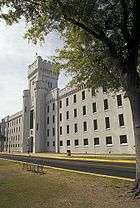Palmetto Regiment

The Palmetto Regiment of Volunteers of South Carolina was an infantry regiment that participated in the Mexican–American War.
History
President James K. Polk called for volunteers for the Mexican–American War and soon in 1846 South Carolina's "Palmetto Regiment" was formed. The regiment provided 10 companies of men, from both US Regular Army and Volunteers. On December 24, 1846 Thomas L. Hutchinson presented the regiment with its first flag. The Regiment received its training from cadets of the South Carolina Military Academy (now The Citadel) with the first use of "drillmasters". The Regimental Flag was described as being made of Blue Silk, with the Coat of Arms of the State of South Carolina upon one side, and the United States Arms and a Palmetto Tree upon the other side, with the Inscription “Presented by the City of Charleston.” The Flag was also reported to have the motto “Not for ourselves we conquer, but our country.”
The Regiment would serve valiantly throughout the campaigns in Mexico, most notably; Vera Cruz, Contreras, Churubusco, Chapultepec, and the Gaita de Belen (A main gate into Mexico City). At the Battle of Churubusco on August 20, 1847, Colonel Pierce Mason Butler and Lieutenant Colonel Dickinson were both mortally wounded while carrying the flag, Dickinson passed the flag onto Major Gladden who then passed the Flag to Lieutenant Baker of Company A, who carried it a short time before giving out due to illness, and turned the banner, once again, over to Major Gladden. Major Gladden passed the Flag to Private Patrick Leonard of Company H who carried the Flag through the remainder of the Battle. At the Battle of Chapultepec and the fighting at the Belen Gate on September 13, 1846, this Flag was the first American Colors that were raised over the City of Mexico. After the War Captain Charles Naylor would write that: “After we had been there sometime, it was suggested that a Flag should be raised to announce our position and success to the other Division’s of the Army. General Quitman ordered a flag to be raised for the purpose. So far as I can remember there was no American Flag there; there was certainly none produced or exhibited. A young officer (whose name I am sorry to say I do not recollect) of the South Carolina Regiment, brought forward the Palmetto Flag, the flag of his regiment and State, and with two of his men and Lieutenant Wilcox (of Quitman’s Staff) clambered to the top of a little shed adjoining the aqueduct, and upon the right of the gate as we enter the city, and from the top of that little shed he raised the Palmetto Flag over the aqueduct, and there held it amid a tremendous fire, provoked for a time into increased severity upon that point by the display of the Flag. There being no means to secure the flag in its place, General Quitman ordered it down; but before this could be done the gallant officer who had planted it and held it, was shot. I aided in getting him own. One of the two men who had charge of the flag, when this officer was wounded, was himself shot just as he leaped down from the shed, and he fell with the flag in his hand, by the side of General Quitman, who was at this time in a greatly exposed position, smoking a cigar, as was his custom, and inspiring the breasts of all around him with his own cheerful daring, unpretentious heroism, and confident security of an immediate, glorious, and final triumph.”
Palmetto Medal
On 8 December 1848 the South Carolina House of Representatives authorized the presentation of medals to the officers and men of the Palmetto Regiment. The Senate concurred five days later. Production and distribution occurred in 1850. It was issued to commissioned officers in gold and to non-commissioned officers and privates in silver. The medal measures 48mm in diameter.
The 16 May 1850 Charleston Courier describes it as follows:
". . .On one side is represented the landing of the American troops at Vera Cruz, the gallant leader of the Palmetto Regiment, Colonel Butler, having sprung from the boat that bore him to the shore, and with drawn sword, is calling on his command to follow—a figure, bearing the beloved Palmetto Flag, is on the prow of the boat, about to leap on shore, and plant the Standard, around which all appear eager to rally. To the right, are serried columns of troops on the line of march toward the Castle at San Juan; while in the distance is seen the American fleet, covering the landing of more troops, which are approaching the shore in boats. Around the edge of this side of the Medal, in raised letters, are the names 'Vera Cruz', 'Contreras', 'Churubusco', Chapultepec', 'Garita de Belen'.
References
External links
| Wikimedia Commons has media related to Palmetto Regiment. |
- South Carolinians in the War with Mexico
- Palmetto Regiment in RootsWeb
- Palmetto Regiment in Aztec Club website
